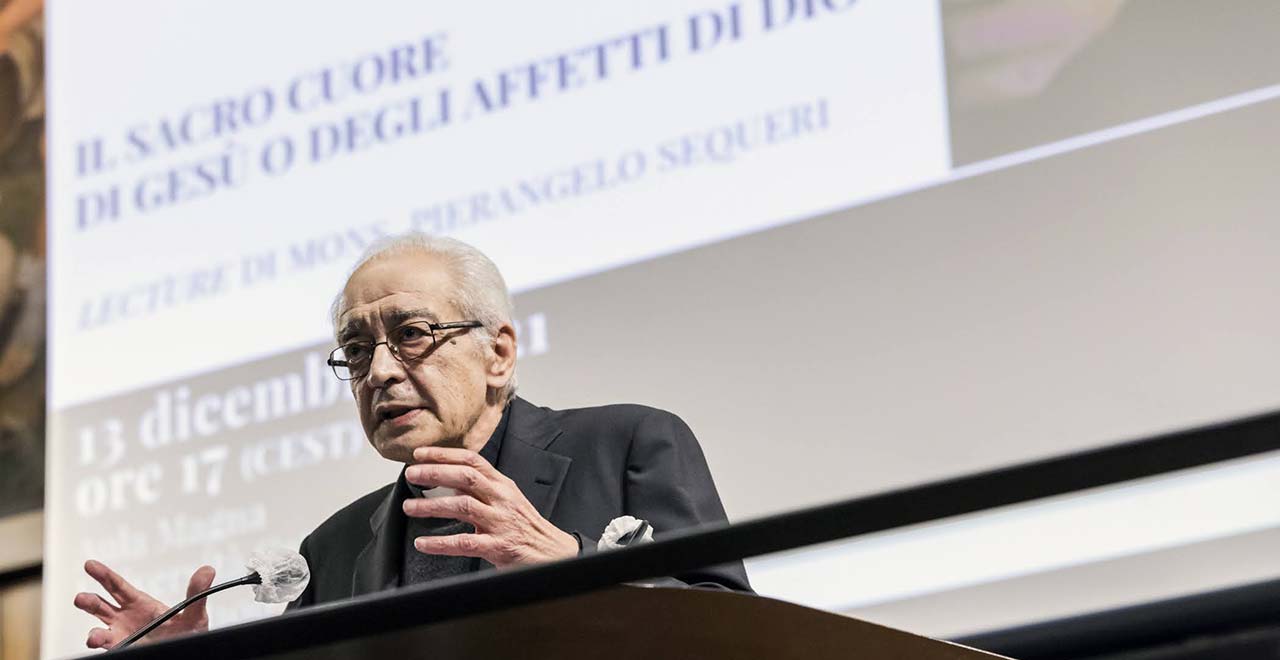"We are full of affections without logos, saturated with logos without affections, totally alien combinations of ties that make man human". Yet, "between the qualities of logos and affections for the things of life" there is an intrinsic relationship. A relationship so profound that, when it is lacking, we "suffer endemically". This is testified to by the "contextual culture" which, without this bond, shows evident "signs of suffering". Hence the "indispensable" and "urgent" challenge that awaits all of us: to become passionate again about the relationship between devotion and reflection, the order of affections and the order of logos.
This is the invitation that Monsignor PierAngelo Sequeri, former Dean of the Pontifical John Paul II Institute for Studies on Marriage and Family, addressed on Monday, December 13, to the audience gathered in the Aula Magna of Università Cattolica and connected via streaming to listen to his lecture "The Sacred Heart of Jesus or the Affections of God", delivered as part of the cycle of conferences "A Century of the Future. The University between the Generations" promoted on the occasion of the Centennial.
A "poet of theology", as he was defined by the General Ecclesial Assistant of the University, Monsignor Claudio Giuliodori, in his introduction, a musician and author of works capable of looking at themes on the borderline between religious sciences, philosophy and aesthetics, Monsignor Sequeri showed the lyricism of his "contemplative soul" through a lecture in tune with the "density" and the "non-extrinsic character" of the relationship between Università Cattolica and the Sacred Heart that forms the header of the University. With a precise aim: to arouse enthusiasm "for an unsolved equation", which from this occasion of celebration and from the deepening of this term ‒ "Università Cattolica del Sacro Cuore" ‒ could receive an "impetus" and offer a "solution".
Monsignor Sequeri's reflection starts from the story of the "grace received", from that apartment in Corso Venezia where Father Gemelli, Armida Barelli, Francesco Olgiati, and Lodovico Necchi met, from the obstinacy of "Ida" and her devotion to the Sacred Heart, from the million donated by Count Ernesto Lombardo which made the "initial miracle" possible with the foundation of Università Cattolica. What is striking about this whole story, Sequeri observed, is precisely the prayer addressed to the Sacred Heart to allow the birth, not of a religious order, a cathedral, a sanctuary, or even a religious, monastic or Benedictine school, but of a university. And he asks himself: "Even today, who would rally around the devotion of the Sacred Heart to establish an institute of higher studies? We, who are so emancipated, would be embarrassed at the idea". There must therefore be a deeper relationship between this symbol and the icon of God's affections. Here then is the unresolved equation. "In this initial miracle, this challenge is taken up in the form of an institution that anticipates ‒ and therein lies the miracle ‒ the very awareness of what a profound relationship worthy of man and worthy of God that must be established between devotion and reflection, the order of the affections and the order of the logos, must mean". An equation, Sequeri added, "still challenging for us", the solution to which is perhaps one "step away from being found". It is up to young people to do this, helped in this by the ground we have prepared for them in these centuries of history.
For example, by putting "the question in the terms of Enlightenment modernity", thus learning the "advantages" and the "rigor" of a thought, of an imperturbable reason that distances itself from religious devotions". A situation, however, in which it was above all the "faith" that appeared as the "summa of devotions" that suffered.
However, even within this dominant culture there has been the "reaction of devotion" which, under the guise of the romantic movement, has advanced the "nobility of the reasons of the heart", considered the organ of the absolute and the place of knowledge of God. But not even from a culture that has alternately ridden these two halves, exalting, on the one hand, a "logos without devotion", and on the other a "devotion without logos", have we received "great resources to dissolve the equation that once again remained unresolved". A split whose consequences we are still paying for today.
This is how we arrive at the history of our decades, with a "contextual culture" that suffers from "the lack of this bond" and begins to question itself about the fate of the new generations, wondering where they are going without an orientation of affections and without attachment to something that is equal to a reason worthy of man. Where is all this leading? To a "surrender" to the beauty of the logos, created by God, and to the power of the affections, which are still divine creations.
In short, we do not have a thought equal to this experience in the face of which the "singularity of Christianity" appears in all its entirety, which is none other than the humanity of the logos that is the rigorous, pure and simple effect of God's sensitivity. Therefore, "we have a faith capable of honouring the theme of an intrinsic relationship between the best qualities of the logos and the most vital forces of affections and devotions for the things of life".
Hence the urgent need to resolve the equation between reflection and devotion for the benefit of the civic community and its generations. "Either we dissolve it or we have no future", warned Sequeri, who identifies precisely in the Sacred Heart the "sign of the possibility" of resolving it. "A truly free mind among both lay thinkers and devout believers, today even more than yesterday, must appreciate this sign, make it great and powerful in the face of the solution of a split that at this moment is becoming a threat to the generations of tomorrow". A sign that must be inhabited with depth, passion, gratitude and with that "capacity for thought" that devotion to the Sacred Heart is capable of arousing in a true believer. Ultimately, "in spite of some residual embarrassed smiles from thinkers and even believers, a Catholic University is appropriate for the Sacred Heart".




